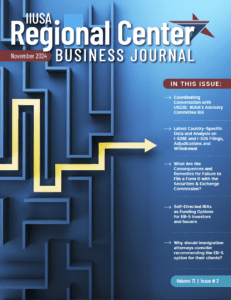Veterans of the EB-5 industry understand that with each EB-5 cycle, new issues arise that require novel solutions. Anyone who’s been monitoring the industry the past few years has noticed an emerging paradox – many investors want to invest after the program re-emerged after 18 months in limbo but are unable due to difficulties faced by the increased investment amount combined with lack of liquidity, currency restrictions, or oftentimes, both. The novel solution that a handful of Regional Centers and issuers have embarked upon is as simple as it is audacious: Why not create a U.S. lender to issue loans directly to EB-5 investors? As explored below, not only is this happening in real-time, this creative alchemy is also made possible through a combination of recent legal developments, market realities, and a uniquely mature EB-5 industry that’s able to fashion a solution.
The need for these types of programs will implore the EB-5 industry to engage in an internal dialogue to consider creating similar solutions that will enable them to work hand-in-hand with their investors.
BACKGROUND
U.S.-based lending programs are no longer an exotic fantasy or a simple marketing advantage. It’s arguably a very real need that must be addressed for any issuer hoping to effectively raise EB-5 capital in today’s environment. There are three main drivers that have made this possible: (1) Zhang v. USCIS, (2) the 2022 EB-5 Reform & Integrity Act, and (3) a clear need from the EB-5 market itself.
Zhang v. USCIS reminds us “cash” isn’t a four-letter word
Zhang v. USCIS was a landmark decision but it was notable because it shed clear light on several commonsense issues that the industry had been noisily arguing for years: cash invested is cash (not indebtedness) and, absent evidence of fraud in lending, it is not USCIS’ place to question a lender’s risk tolerance or business transactions. Zhang made it clear that USCIS’ role isn’t that of an underwriter. Nor should they be. While the implications of Zhang are better explored in a separate article, what is clear is we can now issue secured or unsecured loans to EB-5 Investors to use their EB-5 investment.
The RIA & U.S. Based Lenders
The EB-5 Reform and Integrity Act of 2022 (“RIA”) only reinforced Zhang v. USCIS. Under the RIA, the definitions of lawful capital are more generous if one is a “bank” and its source of funds is presumed to be legitimate without having to provide burdensome source of funds documentation. While the term “bank” isn’t clearly defined by the RIA, as a best practice, people should be ready to provide financials or source of funds for the liquidity used to lend to investors. (Whether it’s through the parent company’s credit lines or similar source).
EB-5 Investors & The Need for a Lifeboat
EB-5 investors are sounding a cry for help where there’s a clear desire to invest, but they need help from issuers and Regional Centers to help fund capital contributions in new commercial enterprises. This has occurred for several reasons:
- Increased Investment Amount: EB-5 investment has increased 40% from $500,000 to $800,000
- Domestically: Laid off people need to invest now, or people can’t close on an alternative loan in time, people have stock portfolios but don’t want to liquidate in a down market
- Overseas: For overseas investors, investors have sufficient funds, but run into currency restrictions and lack of realistic and practical transfer mechanisms
- Raising Interest Rates and Fees for Exchanges: Within a few years, interest rates have skyrocketed from 3 to 4% to 6 to 8%. Currency exchanges went from 1 to 2% to 5%+. Few years ago, nobody would touch this concept because there simple wasn’t any need. Now? it’s different.
CONTINUE READING








